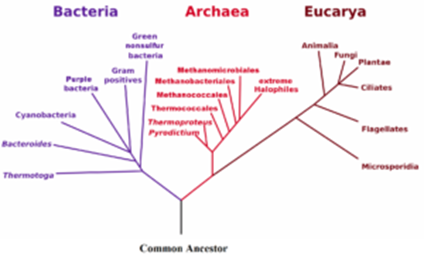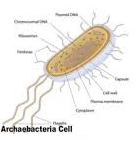Science > Biology > General Biology > Diversity of Living Organisms > Three Domains of Life
Prior to 1969 organisms were classified into two kingdoms: the Plant Kingdom and the Animal Kingdom and on the basis of a cell, organisms were classified into two categories Prokaryotae or Monera (which comprised bacteria) and Eukaryotae (which comprised animals, plants, fungi, and protists). The concept of three domains of life was proposed by Carl Woese and others in 1969. The evolutionary model proposed by them is based on the difference in the sequence of nucleotides in ribosomal RNAs (rRNA) in cells and lipid structure of cell membrane and its sensitivity to antibiotics. According to them, all organisms can be classified into three different domains – Archaebacteria, Eubacteria, and Eukarya. All living things share certain genes, yet no two types of organisms have the same full sets of genes.
Scientists think that all living things have descended with modification from a single common ancestor. Thus, all of life connected. Yet, there are many different lineages representing different species. This diversity stems from the fact that genetic changes accumulate over the years. Also, organisms change as they become suited to their own special environments.
Archaea and Bacteria share a few common characteristic traits but do not have common ancestors. At the same time, they show some peculiar traits of their own. Carl Woese divided Prokaryotae into two groups – Archaea and Bacteria, and thus the concept of three domains of life came into existence.

Reasons for Selecting rRNA for Categorization:
- It is present in all organisms and is the most conserved structure throughout nature
- It is functionally similar between organisms and is involved in protein synthesis
- Its sequence changes slowly and hence can be observed across long periods of time
- The rRNA sequences can be aligned, or matched up, between 2 organisms.
- The nucleotide sequence of rRNA gives a good indication of the relationship in different living groups.
Domain Archaea or Archaebacteria (Greek – archae – ancient):

- These are the most primitive form of life.
- These are the most ancient bacteria. Some fossils found with these bacteria are 3.5 billion years old. As they were from the time of harshest conditions on the earth, they adapted themselves to live in any harshest condition. These bacteria are special since they live in some of the harshest habitats such as extreme salty areas (halophiles), hot springs (thermoacidophiles) and marshy areas (methanogens).
- They have unique cell membrane chemistry. Archaebacteria have cell membranes made of ether-linked phospholipids, while in case of bacteria and eukaryotes both make their cell membranes out of ester-linked phospholipids. The presence of this ether containing linkages in Archaea adds to their ability to withstand extreme temperature and highly acidic conditions.
- Their cell membrane has no peptidoglycans. Archaebacteria use sugar that is similar to, but not the same as, the peptidoglycan sugar used in bacterial cell membranes.
- They are not influenced by antibiotics that destroy bacteria.
- Their rRNA is unique and is much different from the rRNA of bacteria. Their t-RNA and rRNA possess unique nucleotide sequences found nowhere else.
- Most of the archaebacteria are autotrophs. They use pigment bacteriorhodopsin for photosynthesis.
Examples: Extreme halophiles – i.e. organisms which thrive in the highly salty environment, and hyperthermophiles – i.e. the organisms which thrive in the extremely hot environment, are best examples of Archaea.
Classification of Archaebacteria on the Basis of Habitat and metabolic activities:
Methanogens or Methanogenic Archaebacteria:
As they are anaerobic autotrophs, they produce methane as a result of their metabolic activities. They produce methane gas from carbon dioxide and acetic acid from sewage in the marshy condition.
CO2 + 4H2 → CH4 + 2H2O
CH3COOH → CH4 + CO2
Methanogens are present in the gut of several ruminant animals such as cows and buffaloes and they are responsible for the production of methane (biogas) from the dung of these animals. Methane is greenhouse gas that leads to global warming. Methanogens die in the presence of oxygen. Hence they can be found in swamp and marshes in which all oxygen is consumed. The typical smell in these areas is due to the production of methane. Methanogens help in the fermentation of cellulose. They do not decompose the organic matter but utilize the end products of decomposition.
Examples: Methanobacillus, Thiobacillus etc.
Thermoacidophiles or Thermoacidophilic Archaebacteria:
They are aerobic or facultative anaerobic chemoautotrophs. They are adapted to live in extremely hot (about 80 °C) and extremely low temperature (below freezing point) and acidic conditions (pH up to 2). They are found in hot springs (Sulfolobus), in refuse piles of coal mines (Thermoplasma) or geothermal area of Iceland (Thermoproteus).
Most of the thermoacidophiles use hydrogen sulphide as their energy source. They are chemotrophs
2S + 2H2O + 3O2 → 2H2SO4 + Energy (aerobic condition)
Under anaerobic condition, sulphur is reduced to hydrogen sulphide. They precipitate bicarbonate into carbonate due to their activities.
Examples: Thermoplasma, Picrophilus, Thermococci, Pyrococcus, Sulfolobus, etc.
Halophiles or Halophilic Archaebacteria:
They are aerobic or facultative anaerobic heterotrophs. They live in salty environments such as a Great Salt Lake or the Dead Sea, marshes, brine, salt-rich soil where the salt concentration is in range of 2.5 M to 5 M. They have high intracellular concentrations. Their enzymes and ribosomes function efficiently at higher salt concentration.
They contain special photoreceptor pigment called bacteriorhodopsin. Due to which they acquire a purple colour. Bacteriorhodopsin protects halophiles from strong solar radiations. It helps in the synthesis of ATP. It shows the chemotrophic nature of nutrition.
Examples: Halobacteria, halococcus, etc.
Domain Bacteria or Eubacteria:

- These are prokaryotes.
- The cell walls of bacteria; unlike the domains of Archaea and Eukarya, contain peptidoglycan.
- Their membranes are made of unbranched fatty acid chains attached to glycerol by ester linkages.
- They are sensitive to antibiotics.
- They are autotrophs; synthesize their own food, or heterotrophs. Most of the bacterial species are heterotrophs. They get their food from organic matter.
- Naked DNA molecule lies in the cell cytoplasm.
- Only one set of genes, usually in a single-stranded loop is present.
- There is a great deal of diversity in this domain, such that it is next to impossible to determine how many species of bacteria exist on the planet.
- Cyanobacteria and mycoplasmas are the best examples of bacteria.
Domain Eukarya:

- Cells have a eukaryotic organization.
- The cell membrane is composed of a tri-laminar protein-lipid-protein layer similar to that in bacteria.
- Peptidoglycans are not found.
- They are resistant to traditional antibiotics.
- Cells are organized into tissues in case of kingdom Plantae as well as kingdom Animalia.
- The cell was is present only in the kingdom Plantae.
- Eukaryotes are further grouped into Kingdom Protista (euglenoids, algae, protozoans), Kingdom Fungi (yeast, mold, etc.), Kingdom Mycota (Phycomycetes, zygomycetes, ascomycetes, basidiomycetes, Deuteromycetes) Kingdom Plantae (bryophytes, pteridophytes, gymnosperms, and angiosperms) and Kingdom Animalia (all animals).
Another system of grouping organisms divides all life into six major categories called kingdoms. The six kingdoms consist of four kingdoms within the domain Eukarya (the Kingdoms Animalia, Plantae, Fungi, and Protista), one kingdom in the domain Archaea (Kingdom Archaea) and one kingdom in the domain Bacteria (KingdomBacteria). Many biologists recognize these six kingdoms and three domains, but some biologists use other systems of grouping.
Previous Topic: Need For Classification of Living Beings